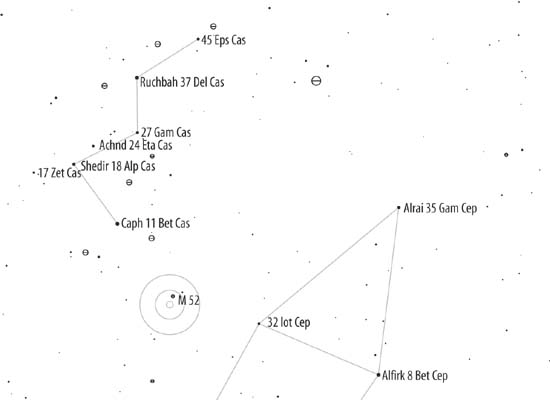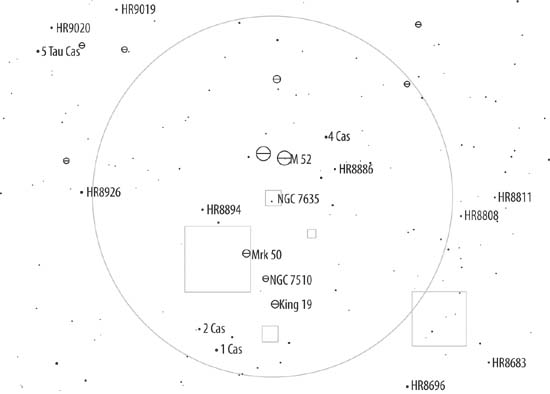Hack18.Print Custom Charts
Hack 18. Print Custom Charts
Make the most of your observing time by taking along the charts you need. Observing time is precious, particularly for DSO observers [Hack #22], many of whom must drive several hours to a dark-sky site on a new moon weekend and hope for clear skies when they arrive. Many DSO observers have half a dozen or fewer opportunities per year to observe under optimum conditions, so it's critical to make the most of that limited observing time. The best way to do that is to be prepared before you set up your scope. Know which objects you plan to observe, and know exactly how you're going to find them. By "exactly" we mean not just knowing the general location of the object, but having a detailed plan, including Telrad [Hack #53] and finder circles plotted and, if necessary, a detailed star hop [Hack #21] worked out. Many observers, including experienced ones, make the mistake of hauling their star atlases and a notebook computer to the observing site, intending to use those resources to locate objects on-the-fly. While you can do it that wayand we would certainly never be without star atlases and our note-book computerit's not the best use of your observing time. With everything pre-planned, we can usually locate one of our target objects in a minute or two at most. If we have to figure out how to locate the object as we go along, it may take as much as half an hour to locate the object through trial and error and then to verify that we've in fact located the object we were looking for rather than some other nearby object. Instead of using your formal charts and planetarium software routinely, reserve them for special needs that arise while you're observing. In general, for formal observing trips, we try to devote at least two hours of planning time for each hour of expected observing time, which is to say 12 hours of planning time for a typical six-hour observing session. (It gives us something to do on those cloudy nights, and planning an observing session is the next best thing to actually observing…) For ad hoc DSO observing sessions, we often fall back on plans from previous sessions that were clouded out. Although it's possible to develop detailed observing plans on paper, using photocopies of printed charts, it's generally easier and much faster to use your computer to produce custom charts with exactly the amount of detail you need. For example, you can set the limiting stellar magnitude in your software to match the limiting magnitude in your finder, so only stars that are actually visible in your finder are plotted on the custom chart, and you can filter the printed output to include only classes of objects you want to observe, such as Herschel 400 objects only or planetary nebulae only.
Sometimes, you'll need only an overview chart and one detailed chart to locate a particular object. For example, Figure 2-11 shows the overview chart for locating the Bubble Nebula (NGC 7635) in Cassiopeia. (Actually, we could have gotten by with just a detailed chart, because, like most experienced observers, we can locate M52 from memory.) The triple ring of the Telrad circle is centered on the Bubble Nebula. Figure 2-11. An overview chart for locating the Bubble Nebula (NGC 7635) in Cassiopeia Figure 2-12 shows the detailed chart for locating the Bubble Nebula. The circle is a 5° finder circle, which we would jot down on the printed chart. Otherwise, it's easy to forget whether a circle on a chart is for the finder or for one eyepiece or another. This detailed chart actually serves for finding more than just the Bubble Nebula. While we were in the vicinity, we'd also locate and log the open clusters NGC 7510, King 19, and Markarian 50 [Hack #26]. We wouldn't need another detailed chart for these objects because they happen to be in close proximity to each other and near the bright stars 1 Cas and 2 Cas (at the lower left of the finder circle). Both of those stars and all three of the open clusters would be within the field of our wide-field eyepiece. Figure 2-12. A detailed chart for locating the Bubble Nebula (NGC 7635) in Cassiopeia One detailed chart usually suffices for finding an object. But there are timesfor example, when you need to do a long star hop to locate a dim object far from any bright starwhen you'll need more than one detailed chart to map the trail from your starting point to the object. Don't hesitate to print as many charts as necessary to get you to your goal, but do remember to number them in sequence so you'll know what order to follow them in.
Custom charts are particularly important when you are observing transient events such as comets, transits and shadow transits of Jupiter's Gallilean moons, and the dance of Saturn's satellites. For example, Figure 2-13 shows the position of Saturn's major satellites as of 7:30 p.m. on 7 February 2005, with a one arcminute circle shown for scale. Figure 2-13. The locations of Saturn's major satellites at a particular date and time Some of Saturn's moonsTitan, Rhea, Dione, and Tethysare easy to observe even in a small scope because they are relatively bright, well separated from the glare of Saturn, or both. Although we have observed both in our 10" Dob, Encelade and, in particular, Mimas, are much more difficult because they are dimmer and because their orbits keep them so close to Saturn. We have never managed to observe Hyperion, which at magnitude 14.0 is right at the limit of our scope. All of these moons appear stellar regardless of magnification, so the only way you can verify that you are looking at a moon rather than a dim field star is to have such charts for the particular evening or even the particular hour of the evening when you will observe the object.
|
EAN: 2147483647
Pages: 112
